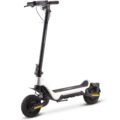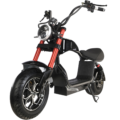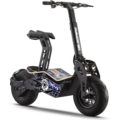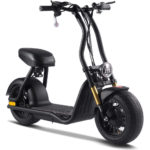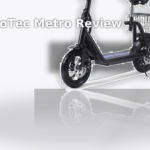- Home
- Scooters
- Electric Scooters
- MotoTec Mars
MotoTec Mars


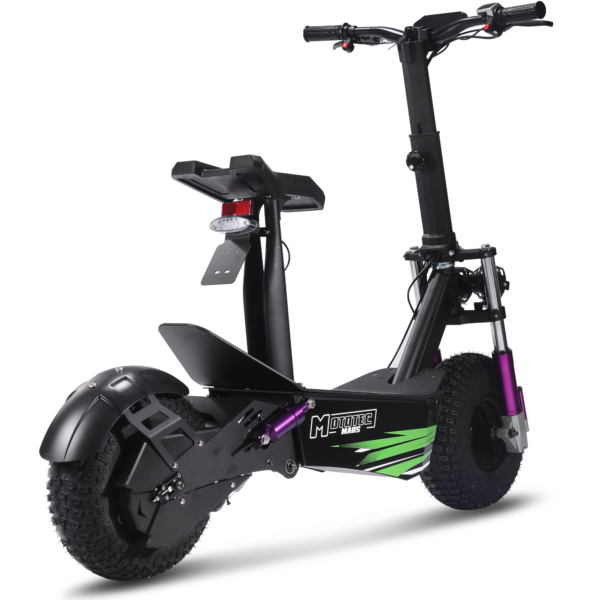
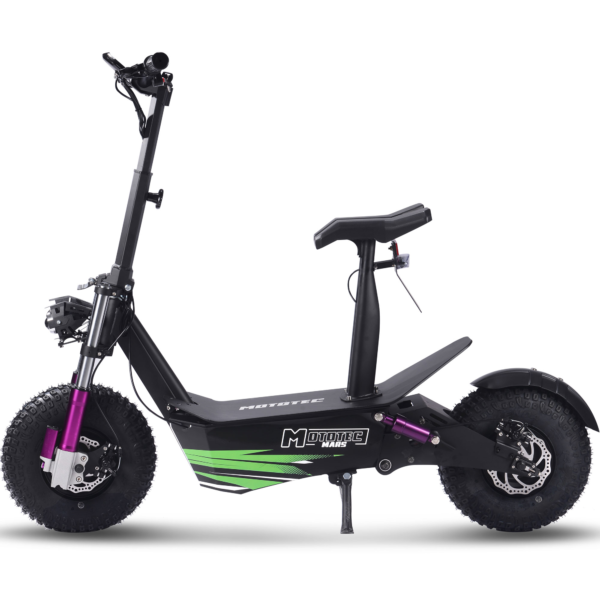
- Battery Range: 20–28 miles (32–45 km)
- Top Speed: 30 mph (48 km/h)
- Motor Power: 2500 W
- Weight Capacity: 330 lb (150 kg)
- Charging Time: ~4–6 h
- Scooter Weight: 110.2 lb (50.0 kg)
PROS
- 2500W hub motor; 30 mph top speed
- 20–28 mi range from 48V 20Ah pack
- Dual front & rear suspension
- Front & rear disc brakes
- Foldable frame with seat
CONS
- Very heavy at ~110 lb
- No stated IP rating
- No app or smart features
- Hill-climb grade not specified
Key Takeaways
- The MotoTec Mars is a heavy, foldable electric scooter available in 48V 2500W and 60V 3500W versions, offering strong torque and comfort.
- It features a sturdy steel frame, aluminum deck, removable seat, and dual shock suspension for a relaxed ride.
- Braking consists of mechanical disc brakes, providing firm bite and modulation for safe stops.
- Both models have a range of 20–28 miles for the 48V and 25–28 miles for the 60V, depending on rider weight and terrain.
- The MotoTec Mars is ideal for larger riders and suburban routes but may not suit those in walk-up apartments or needing a lightweight option.
Table of contents
- What Is the MotoTec Mars?
- How the MotoTec Mars Works
- Key Specifications
- Design & Build Quality
- Performance Fundamentals
- Battery, Range & Efficiency
- Ride Quality & Comfort
- Braking & Safety Features
- Portability & Daily Usability
- Maintenance & Care
- Weather & Seasonal Considerations
- MotoTec Mars vs Alternatives
- Who the MotoTec Mars Is (and Isn’t) For
- FAQs
- Glossary
- Final Thoughts
The MotoTec Mars is a big, sit-or-stand electric scooter built for comfort and punch. You can buy it in two flavors, a 48V 2500W version and a 60V 3500W version. If you want strong torque, a wide deck, and chunky street tires, it fits. This guide keeps things simple, and it covers what works great and what needs care. If you prefer a lighter MotoTec for short hops, the MotoTec 2000W 48V Electric Scooter is a handy reference point.
What Is the MotoTec Mars?
The MotoTec Mars is a heavy, foldable scooter with a removable seat, twin shocks, and disc brakes at both ends. It suits riders who like a relaxed posture and a planted feel. The frame is steel and the deck is aluminum. The listed load rating is 330 lb (150 kg), so bigger riders can ride with confidence. The 48V model runs a 2500W rear hub motor, and the 60V steps up to 3500W. Pop the seat on for longer rides, or pull it off for a clean stand-up layout.
How the MotoTec Mars Works
Power comes from a brushless hub motor inside the rear wheel. A controller sits between the battery and motor, and it meters current when you twist the throttle. Think of it as a smart valve. You ask for power with your wrist, and the controller opens the gate in smooth steps. So takeoff feels strong, and cruising stays steady.
Braking is simple and proven. You get mechanical discs front and rear. Pull the levers and the pads clamp steel rotors. Bite is firm, and modulation feels natural with one or two fingers. Suspension uses twin shocks up front and twin at the rear, so the deck stays level over seams and patched asphalt. Lighting starts with dual headlights. One version lists only the headlights. The other notes no horn, no brake light, and no turn signals.
The cockpit uses a twist throttle and a small speedometer with an odometer. Bars run wide, which helps leverage. Mirrors give a clear look behind when you ride seated, and you can remove them if you prefer a clean bar.
Key Specifications
| Section | Item | Mars 48V 2500W | Mars 60V 3500W |
|---|---|---|---|
| General | Frame | High-tensile steel | High-tensile steel |
| Deck | Aluminum | Aluminum | |
| Seat | Included (removable post) | Included (removable post) | |
| Foldable stem | Yes | Yes | |
| Rated load | 330 lb (150 kg) | 330 lb (150 kg) | |
| Recommended age | 13+ years | 13+ years | |
| Performance & Power | Motor | 2500W rear hub (48V) | 3500W rear hub (60V) |
| Top speed | 30 mph (48 km/h) | 32 mph (52 km/h) | |
| Tires (size) | 130/50-8 | 130/50-8 | |
| Brakes | Front and rear disc | Front and rear disc | |
| Battery, Charging & Electrical | Battery | 48V 20Ah lithium | 60V 30Ah lithium |
| Nominal energy (calc) | 960 Wh | 1800 Wh | |
| Charge time | 4–6 hr | 4–8 hr | |
| Throttle | Twist | Twist | |
| Lights | Headlights | Headlights | |
| Horn | Not stated | No | |
| Signal lights | Not stated | No | |
| Brake light | Not stated | No | |
| Build & Dimensions | Scooter size (L×W×H) | 57.1 × 18.5 × 44.1 in (1450 × 470 × 1120 mm) | 57.1 × 18.5 × 44.1 in (1450 × 470 × 1120 mm) |
| Folded dimensions | Not stated | Not stated | |
| Scooter weight | 110 lb (50 kg) | 132 lb (59.9 kg) | |
| Box size | 57 × 13 × 27 in (145 × 33 × 69 cm) | 57 × 13 × 27 in (145 × 33 × 69 cm) | |
| Box weight | 122 lb (55.3 kg) | 141 lb (64 kg) | |
| Safety & Control | Suspension | Dual front shocks, dual rear shocks | Dual front shocks, dual rear shocks |
| Mirrors | Included in product description | Included in product description | |
| Speedometer/odometer | Yes | Yes | |
| IP rating | Not stated | Not stated | |
| Features & Extras | Seat post | Included | Included |
| Cruise Control | Not stated | Not stated | |
| Warranty & Compliance | Warranty | 30-day parts replacement | 30-day parts replacement |
That table covers the core specs in one place. It gives a quick way to size the scooter, compare versions, and plan daily use.
Design & Build Quality
The Mars feels stout from the first lift. The steel frame shrugs off dings and holds its shape under load. The aluminum deck gives your feet room to move. So you can square up for takeoff, then stagger your stance for longer runs.
Fit and finish sit in the “tough and tidy” lane. Welds look clean. Paint has a simple gloss with a clear protective top. Cables are easy to trace, which makes service less annoying. The folding joint locks with a firm bite, so the stem stays quiet when you roll out. Then the wide bars give you leverage in tight turns and a relaxed grip on long straight segments.
The 130/50-8 tires spread a nice contact patch. So grip is predictable on patched streets and pavers. The twin shocks take the edge off sharp hits. You still feel the road, which is good, but the jolt softens. The seat post tightens down well and holds still if you set it right. Many riders keep the seat on for errands and longer runs. Others pull it for stand-up control. Either way works.
Performance Fundamentals
Both versions step off the line with authority. The 48V 2500W model jumps cleanly and holds speed on flat ground. The 60V 3500W adds headroom. So it pulls harder and keeps pace better if you weigh more or face steady headwinds.
Stability is the headline. The long deck and wide bars give you a strong base, and the shocks help the tire stay in touch with the ground. So tracking straight over cracks and joints feels calm. At higher speeds, keep your elbows bent and your touch light. The front will absorb small hits, and the chance of wobble drops.
For hills, think about grades in the 7–10% range as the practical sweet spot. The 60V holds speed longer on climbs. The 48V still makes it up, though you may feel it start to taper near the top. On very steep alleys, both slow. Lean forward a bit to keep the front planted and let the rear hook up.
Battery, Range & Efficiency
The 48V model lists a 20Ah pack, and the 60V lists a 30Ah pack. That puts nominal energy near 960 Wh and 1800 Wh. The math is simple voltage times amp-hours. So you can translate that into rough miles by thinking about pace, terrain, and rider weight.
Claimed ranges land here: 20–28 miles (32–45 km) for the 48V and 25–28 miles (40–45 km) for the 60V. Real roads vary. A 200 lb rider on rolling streets will see fewer miles than a 150 lb rider on flat paths. Cold trims range. Headwinds trim range. Fast cruising draws more current than a mellow pace. So leave a buffer, and plan to stop short of the full claim if your loop has hills or frequent stops.
Charging is straight. The 48V pack lists 4–6 hours. The 60V lists 4–8 hours. Top up during the day when it helps. Then let the pack rest a few minutes after a hard ride before you plug in. Heat settles, and cell stress drops.
Good charging habits go a long way. Keep the scooter near room temperature. Skip storing the pack full or empty for weeks. Park it near the middle if you plan a pause. Keep the port cap clean so dust stays out.
Ride Quality & Comfort
Comfort starts with stance. The deck is wide and the bars sit high, so you ride with a natural bend at the knees and elbows. The twin shocks knock down sharp hits from joints and covers. You still get feedback, which helps feel, yet the worst spikes soften. The seat adds another layer. Long straight runs feel easier on your knees and lower back when you sit.
Tire type varies by batch and seller. Many units ship with street-focused “fat” tires that roll smooth and plant well in corners. If yours are pneumatic, check pressure often. Low pressure adds drag and ups pinch risk. If yours are solid, expect more road buzz and long wear. Either way, keep an eye on tread and cuts. A quick weekly spin-and-look is enough.
The stem lock feels firm. Steering is direct, and stem flex is low when you brace the deck and rock the bar. That solid feel boosts confidence at city speeds. The deck is long enough to shift your feet during a ride, which eases fatigue and helps control.
Braking & Safety Features
Both versions use front and rear discs. Lever feel lands in a nice spot about halfway through the pull. So you can feather the front and bring in the rear to stand the scooter up at the end. Find an empty lot and do a few practice stops. You will see how it slows with the seat on and how it slows when you stand.
Lighting starts with headlights. One version lists no horn, no brake light, and no turn signals. The other lists only headlights and the basics. So add passive reflectors to your helmet, bag, or seat post if you ride at dawn or dusk. Wear a bright top. Small choices help drivers pick you out sooner.
No water-ingress rating appears in the published material. So treat wet rides with care. Slow near paint, plates, and leaf piles. Brake earlier. Then dry the rotors with a few light squeezes after you clear a puddle.
Portability & Daily Usability
The MotoTec Mars is not a featherweight. The 48V model lists about 110 lb (50 kg). The 60V lists about 132 lb (59.9 kg). So carrying it up a flight is possible, yet not fun. The fold helps for car trunks and sheds, and the stem latch holds tight. It fits in many hatchbacks with the rear seats down. The box dimensions give you a rough picture of transport fit if you keep it packed for trips.
For storage, pick a dry, stable spot. Lock it to a fixed point if you park in a shared garage. Give the charger air space and keep it off piles of stuff. Daily routines pay off. Glance at the tire tread. Spin the wheels and listen for rub. Check the stem clamp, seat collar, and caliper bolts. A small torque wrench saves grief.
Maintenance & Care
Keep a simple schedule:
- Before every ride: Squeeze both levers. Feel for firm bite. Scan the tire surfaces for cuts. Turn the bars lock to lock and listen for cable bind.
- Weekly: Check stem clamp hardware and the seat post collar. Wipe the deck and bars with a damp cloth and look for chips or cracks. Top up the battery if it sits under half.
- Monthly: Inspect brake pads. Replace thin pads. True the rotor if rubbing remains after a caliper re-center. Check wheel nuts for snug fit. Clean the charger contacts with a dry brush.
- Quarterly: Inspect shock mounts and bushings. Replace crushed washers or worn bushings. Check mirror threads and add a dab of medium thread locker if they loosen often. Then take a short shakedown ride to confirm all feels right.
- As needed: For pneumatic tires, set pressure to the mid-range printed on the sidewall. That balance keeps grip and comfort in line. For solid tires, watch for chunking and replace at the first deep cuts.
Treat the battery with care. Skip full discharges. Store the scooter near half charge if it sits for a few weeks. Keep the pack cool and dry.
Weather & Seasonal Considerations
Rain changes grip and visibility. No IP rating appears, so play it safe. Slow down in light rain, and skip standing water. Back home, dry the scooter. Wipe rotors, and brush grip tape to bring texture back.
Heat and cold affect range. Very hot days can push the pack toward thermal limits. Very cold days trim power until the cells warm. So plan shorter routes in heat waves and cold snaps. Keep the scooter indoors when you can. In winter, ride the first mile at an easy pace so the tires warm a touch.
For seasonal storage, wash the deck and frame, dry carefully, and charge to about 50–60%. Then park it in a dry, room-temp space. Wake the pack with a short top-up every month.
MotoTec Mars vs Alternatives
The Mars lands between small commuters and wild performance rigs. It weighs more and feels more relaxed than the slim city crowd. It keeps things simpler than extreme sport builds with huge batteries and hydraulic systems. If you want to compare a different big-deck approach, the Joyor S10-S-Z review shows how a lighter chassis changes day-to-day handling.
Mars vs Raven. The Raven is another large MotoTec built for comfort and range. The Mars 60V brings a bigger motor on paper and a wider tire footprint. So it suits long, straight routes and heavier loads. The Raven fits riders who want a similar vibe with a different frame and battery mix.
Mars vs commuter class. Light commuters win on stairs and crowded trains. They fold fast and carry easy. The trade is power, range, and deck size. The Mars wins on comfort and stability, and it carries bigger riders with less strain.
Mars vs performance class. Top-tier scooters push higher speeds, larger packs, and hydraulic brakes. They weigh more and cost more. The Mars gives you strong shove, twin shocks, and a seat without going all-in on weight and complexity.
Mars vs off-road builds. Purpose-built trail scooters use knobby tires and taller suspension. They shine on dirt. The Mars favors paved streets and light gravel. It can handle smooth trails, yet city routes remain its home turf.
Who the MotoTec Mars Is (and Isn’t) For
Great for:
- Bigger riders who want space, torque, and a seat.
- Suburban routes with long, straight segments.
- Short commutes with garage or shed charging.
- Errand runs with a basket or soft bag.
- Riders who prefer a planted, calm feel.
Not ideal for:
- Walk-up apartments with lots of stairs.
- Tight city cores with frequent carry segments.
- Riders who want a super light scooter.
- Wet regions where an IP rating is a must.
If you want a sturdy platform that feels steady, the MotoTec Mars makes sense. If you fold and carry a lot, a lighter commuter fits better.
FAQs
Does the MotoTec Mars have different versions?
Yes. You will see a 48V 2500W model and a 60V 3500W model. Both pull hard, and the 60V has more headroom.
Which version is better for long hills?
Pick the 60V 3500W. It holds speed longer and feels less strained with extra weight.
What range should I expect in real use?
Aim below the claim if you ride fast, weigh more, face wind, or climb hills. The 48V lists 20–28 miles. The 60V lists 25–28 miles. Your loop and pace decide the final number.
Does it have a brake light or turn signals?
One version lists only headlights. Another notes no horn, no brake light, and no turn signals. So use reflectors and bright gear for visibility.
What tire type comes stock?
The maker lists size, not casing type. Many units ship with street-focused “fat” tires. Check your sidewalls for pressure info if they are pneumatic.
Can I ride in the rain?
No published IP rating appears. So treat rain with care, slow down near slick paint and plates, and keep out of deep puddles.
Where can I read a quick MotoTec Mars overview?
You are reading it now. This is your MotoTec Mars overview in plain language.
Glossary
- Ah (amp-hours): A measure of charge. Higher Ah means more stored energy at a given voltage.
- Wh (watt-hours): Voltage times amp-hours. A rough energy total for range planning.
- Controller: The box that meters current to the motor when you twist the throttle.
- Hub motor: A motor built into the wheel hub that drives the wheel directly.
- Torque: Rotational force from the motor that moves the scooter off the line.
- Stem clamp: The latch that locks the folding stem for riding.
- Stem flex: Small bending you may feel in the steering tube under load.
- Disc brake: Pads clamp a steel rotor to slow the wheel.
- Rotors: The round steel discs the pads grab.
- Regen: Electronic braking that feeds energy to the battery. The Mars lists mechanical discs and no regen.
- IP rating: A dust and water rating. None is shown here.
- Load rating: The max rider weight the scooter is designed to carry.
- Sidewall pressure: The inflation range printed on pneumatic tires.
- Top speed: Fastest speed on level ground in ideal settings.
- Watt-hours per mile: A rough measure of energy use per mile.
Design & Build: Practical Notes
Set bar angle so your wrists stay neutral. Then set lever reach so your index and middle fingers land on the hooks. If you use the seat, set height so your knees keep a small bend at the bottom of the stroke. Long rides feel smoother with that setup.
Add a small bell for bike paths. If you ride near traffic at dusk, clip a bright tail light to the seat post. Reflective tape on your helmet or bag helps more than you think.
Performance: Practical Notes
Start rides in a relaxed stance. Bend your elbows and keep your knees soft. Then roll on the throttle. Traction improves, and range goes further. For hill starts, lean forward and keep your body loose. If the rear spins, ease off, then roll back on.
Braking: Practical Notes
Practice a few stops from 15 mph in a quiet lot. Use more front than rear in a straight line. Keep the bars straight as you add pressure. If pads rub on a stand, re-center the caliper and lightly true the rotor. Do a few firm stops to bed the pads.
Battery & Charging: Practical Notes
Let the pack cool a few minutes after a hard run. Then charge. Stop near full if you will ride soon. Pause near half if you will store it. Keep the charger on a hard surface with air around the brick.
Storage & Transport: Practical Notes
Fold the stem and secure it so it does not swing in the car. Use a strap or hook. Lift with your legs, and keep the deck close to your body. Pad any sharp spots that might scuff your interior.
Final Thoughts
The MotoTec Mars is a big, stable scooter that trades lightness for comfort and punch. The 48V model covers medium routes with solid torque. The 60V model adds power for heavy riders and steady hills. Both feel planted, easy to service, and flexible with the seat on or off. Pick based on your route, terrain, and how often you plan to sit. Then keep up with quick checks and sane charging, and it should serve you well.
Specifications
General
| Model The Model specifies the exact version or name of the scooter. It helps identify its unique design, features, and specifications within the manufacturer’s product line. Knowing the model makes it easier to compare options, find compatible accessories, or look up support information. | Mars |
| Brand The Brand identifies the manufacturer or company that designs and produces the scooter. A trusted brand is a sign of quality, reliability, and good customer support. Well-known brands often have higher standards for safety, performance, and after-sales service, giving you more confidence in your purchase. | MotoTec |
| Release Date The Release Date indicates when the scooter model was officially launched on the market. This helps you know how current the design, technology, and features are. A newer release date often means updated components, improved performance, and the latest safety or smart features. | 18 November 2025 |
| Recommended Age Recommended Age indicates the minimum age range that the scooter is designed for, based on safety, size, and ease of use. Following the recommended age helps ensure that riders can handle the scooter’s speed, weight, and controls comfortably and safely. Always check local laws and use protective gear, especially for younger riders. | 13+ |
Performance & Power
| Motor Power (Wattage) What it means: The motor power, measured in watts (W), shows how strong the scooter’s electric motor is. Why it matters: Higher wattage usually means better acceleration, more torque, and improved performance on hills or rough terrain. For example, a 250W motor is good for flat city roads and light riders, while a 500W or 1000W motor provides more power for faster speeds or climbing steep inclines. | 2500 W 48 V hub motor |
| Top Speed The Top Speed indicates the maximum speed that the scooter can reach under optimal conditions. It’s usually measured on level ground with a fully charged battery and an average rider weight. A higher top speed allows you to travel longer distances faster, but always ensure you ride within legal speed limits and your personal comfort zone for safety. | 30 mph (48 km/h) |
| Battery Capacity Battery Capacity refers to the total amount of energy the scooter’s battery can store, usually measured in ampere-hours (Ah) or watt-hours (Wh). A higher battery capacity means you can ride longer distances on a single charge, reducing the need for frequent recharging. Keep in mind that actual range can vary depending on rider weight, terrain, speed, and weather conditions. | 48 V 20 Ah (≈960 Wh) |
| Estimated Range per Charge The Estimated Range per Charge indicates the average distance the scooter can travel on a single full battery charge. This range is calculated under optimal conditions, such as flat terrain, moderate speed, and average rider weight. Real-world range may vary depending on riding style, terrain, weather, and load. A longer range means fewer recharges and greater freedom for longer trips. | 20–28 miles (32–45 km) |
| Hill Climb Ability Hill Climb Ability describes the maximum incline or slope that the scooter can handle while maintaining stable performance. It’s typically expressed as a percentage or in degrees. A higher hill climb rating means the scooter can tackle steeper hills without losing too much speed or power. Actual climbing performance may vary based on rider weight, battery charge, and terrain conditions. | Not specified |
| Drive System The Drive System refers to how power from the motor is delivered to the wheels. Electric scooters typically use either a hub motor (directly integrated into the wheel) or a chain/belt drive system. A high-quality drive system ensures smooth acceleration, efficient power transfer, and low maintenance. The choice of drive system affects performance, noise level, and overall ride experience. | Hub-driven (wheel position not specified) |
Charging & Electrical
| Charging Time Charging Time indicates how long it takes to fully recharge the scooter’s battery from empty to 100% using the standard charger provided. Faster charging means less downtime and more time on the road. Actual charging time may vary slightly depending on battery capacity, charger output, and environmental conditions. | Approx. 4–6 hours |
| Battery Type Battery Type refers to the specific technology used in the scooter’s battery, which affects performance, lifespan, weight, and charging time. Most modern electric scooters use high-quality lithium-ion (Li-ion) batteries because they offer a good balance of energy density, durability, and low maintenance. A reliable battery type ensures consistent power delivery and longer riding ranges. | Lithium-ion pack |
| Removable Battery A Removable Battery means the battery pack can be easily detached from the scooter for convenient charging and replacement. This feature allows you to charge the battery separately, swap it with a spare for extended range, or securely store it indoors in extreme weather. Removable batteries add flexibility and make it easier to keep your scooter powered up wherever you are. | Non-removable internal battery (fixed pack) |
| Regenerative Braking Regenerative Braking is an energy-saving feature that converts some of the energy normally lost during braking back into battery power. When you slow down or brake, the motor works in reverse to generate electricity, which helps extend the scooter’s range and improves overall efficiency. This system also reduces wear on traditional brake components, leading to lower maintenance over time. | Not specified |
| Lighting Lighting refers to the built-in front and rear lights that enhance visibility and safety when riding in low-light conditions or at night. Good lighting helps you see the road ahead and ensures that other road users can see you. Many scooters include LED headlights, taillights, and sometimes brake lights or side reflectors for added safety and compliance with local traffic regulations. | Dual LED headlights; other lighting not specified |
Build & Dimensions
| Scooter Weight Scooter Weight refers to the total weight of the scooter when fully assembled, including the battery. This affects how easy it is to carry, lift, and store the scooter when not in use. A lighter scooter is more portable and convenient for commuting, especially if you need to carry it upstairs or onto public transport. Keep in mind that a sturdy frame and quality components may add to the weight but also contribute to better durability and ride stability. | 110.2 lb (50.0 kg) |
| Maximum Rider Weight Maximum Rider Weight indicates the highest rider weight that the scooter is designed to safely support while maintaining optimal performance and stability. Staying within this limit helps ensure reliable acceleration, braking, and climbing ability, and it protects the frame, suspension, and motor from excessive strain. Exceeding the recommended limit may reduce performance and increase wear on components. | 330 lb (150 kg) |
| Deck Size Deck Size refers to the dimensions of the scooter’s standing platform. A wider and longer deck provides more foot space, allowing you to stand comfortably and adjust your stance while riding. A well-sized deck improves balance and stability, especially on longer rides or at higher speeds. Compact decks, on the other hand, help keep the scooter lightweight and portable. | Low deck; wide foot platform |
| Handlebar Height Handlebar Height refers to the distance from the deck to the handlebars, which affects your riding posture and comfort. An appropriate handlebar height helps you maintain good balance, reduces strain on your back and arms, and makes steering more comfortable. Some scooters have adjustable handlebars to fit riders of different heights, while others have a fixed height for a streamlined design. | Fixed (height not specified) |
| Folding Mechanism The Folding Mechanism describes how easily and securely the scooter can be folded for carrying and storage. A well-designed folding system lets you quickly collapse the scooter into a compact size, making it convenient to transport on public transit, store under a desk, or fit into a car trunk. Look for sturdy latches and safety locks to ensure the scooter stays firmly in place when folded or unfolded. | Foldable; mechanism not specified |
| Dimensions Folded Dimensions indicate the size of the scooter when it’s fully folded. This measurement shows how much space the scooter will take up when stored or carried, making it easier to check if it will fit in your car trunk, under a desk, or in a closet. Compact folded dimensions are ideal for commuters who need to bring their scooter on public transport or store it in tight spaces. | Unfolded: 57.1 × 18.5 × 44.1 in (1450 × 470 × 1120 mm); Folded: Not specified |
| Material Material refers to the primary construction materials used for the scooter’s frame and key components. High-quality materials like aircraft-grade aluminum, reinforced steel, or durable composites provide strength, stability, and a lighter overall weight. A sturdy material ensures the scooter can handle daily wear and tear while maintaining safety and performance. | High-tensile steel |
Safety & Control
| Brake Type(s) Brake Type(s) describe the braking systems the scooter uses to help you slow down or stop safely. Common brake types include mechanical brakes (like drum or disc brakes), electronic brakes, and foot brakes. Many scooters combine multiple braking systems for added safety and shorter stopping distances. The type and quality of brakes affect your control, especially when riding at higher speeds or on slopes. | Front & rear disc brakes |
| Suspension Suspension refers to the system that absorbs shocks and vibrations while riding, providing a smoother and more comfortable ride over uneven or rough surfaces. Scooters may have front suspension, rear suspension, or dual suspension for better shock absorption and stability. Good suspension helps reduce rider fatigue and improves control, especially when riding on bumpy roads or off-road paths. | Dual front & dual rear |
| Tire Type Tire Type refers to the kind of tires the scooter uses, which directly affects ride comfort, traction, and maintenance. Common types include solid (airless) tires, pneumatic (air-filled) tires, or hybrid options. Pneumatic tires offer better shock absorption and a smoother ride on rough surfaces, while solid tires are puncture-proof and require less upkeep. The right tire type helps ensure safe handling and a comfortable ride in different conditions. | 130/50-8 street tires |
| Tire Size Tire Size indicates the diameter and width of the scooter’s tires, which affect ride comfort, stability, and how well the scooter handles different terrains. Larger tires generally offer better shock absorption and a smoother ride over bumps and rough surfaces, while smaller tires keep the scooter lighter and more portable. Choosing the right tire size helps ensure a balance between agility and comfort. | 8-inch |
| Kickstand The Kickstand is a built-in stand that allows you to park your scooter upright when it’s not in use. A sturdy kickstand keeps the scooter stable and prevents it from tipping over, protecting it from scratches and damage. It also makes storing and accessing your scooter more convenient, whether you’re at home, work, or on the go. | Not specified |
| Water Resistance Rating Water Resistance Rating indicates how well the scooter is protected against water and moisture, usually shown as an IP (Ingress Protection) rating. This rating helps you understand whether the scooter can handle light rain, splashes, or wet roads without damage. While most scooters are not fully waterproof, a good water resistance rating adds peace of mind when riding in changing weather conditions. Always avoid deep puddles or submerging the scooter to protect its electrical components. | Not specified |
Features & Extras
| Display/Console The Display (or Console) shows important real-time information about your ride, helping you monitor your scooter’s status at a glance. Typical displays show speed, battery level, distance traveled, and riding mode. Some models also include additional features like Bluetooth connectivity, app integration, or backlighting for better visibility at night. A clear and easy-to-read display enhances safety and convenience on every trip. | Speedometer/odometer |
| Ride Modes Ride Modes refer to the different speed and power settings you can choose to match your riding style or road conditions. Common modes include eco for maximum range and energy efficiency, standard for everyday balance, and sport or turbo for higher speed and stronger acceleration. Switching between ride modes allows you to customize performance, conserve battery, and ride safely in various environments. | Not specified |
| Smart App Connectivity Smart App Connectivity lets you pair your scooter with a dedicated mobile app via Bluetooth. Using the app, you can monitor real-time ride stats like speed, battery level, and range, adjust settings such as ride modes or cruise control, lock the scooter for added security, and sometimes receive firmware updates. This feature adds convenience and allows you to personalize your riding experience right from your smartphone. | No app |
| Anti-Theft System The Anti-Theft System helps protect your scooter from unauthorized use or theft. This feature can include built-in alarms, electronic motor locks, GPS tracking, or remote locking through a mobile app. A good anti-theft system provides peace of mind when parking your scooter in public spaces, adding an extra layer of security to safeguard your investment. | Not specified |
| Cruise Control Cruise Control allows you to maintain a steady speed without continuously holding the throttle. This feature makes longer rides more comfortable by reducing hand fatigue and providing a smoother, more relaxed riding experience — especially on flat, open roads or bike lanes. For safety, cruise control can usually be easily activated or deactivated while riding. | Not specified |
| Accessories Included Accessories Included lists the additional items that come with the scooter to enhance your riding experience and convenience. Common accessories may include a charger, kickstand, bell, lights, phone holder, or carrying strap. These extras add value by making your scooter safer, easier to use, and ready to ride straight out of the box. | Not specified |
Warranty & Compliance
| Warranty Period The Warranty Period indicates how long the manufacturer guarantees the scooter against defects in materials and workmanship under normal use. A good warranty provides peace of mind, showing the brand’s confidence in its product quality. Always check what parts are covered, such as the frame, battery, and motor, and follow the maintenance guidelines to keep your warranty valid. | 30 days parts replacement |
| Certifications Certifications confirm that the scooter meets specific safety, quality, and environmental standards set by recognized organizations or regulatory bodies. Common certifications may include CE, RoHS, UL, or other local compliance marks, depending on your region. These certifications ensure that the scooter is manufactured to high standards and is safe and legal to use in your country. | UL 2272 (brand statement); region-dependent |


